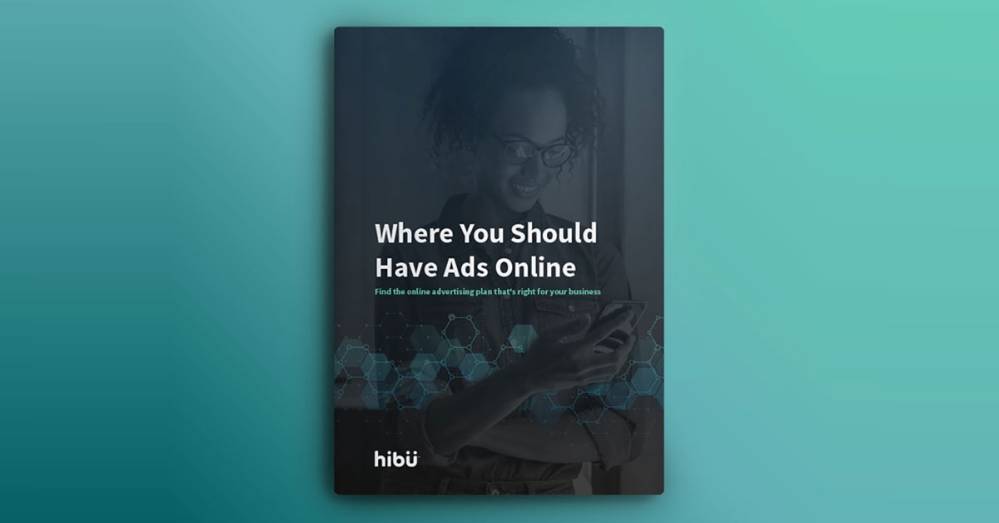
The Complete Guide to Where You Should Advertise Online [Free Guide]
By Hibu |
These days, we’re surrounded by advertising messages. Everywhere we look, something is sponsored by a brand trying to get their name out there. So how are you supposed to get your business noticed?
For local businesses especially, it may seem an impossible task when you start to examine all the possible places to advertise your business online. Luckily, we’re here to guide you through this crowded (and often confusing) space.
Download the full guide now so you can read it whenever you want
No matter your marketing budget or how you decide to spend it, it's a smart move to put some of that budget towards online advertising. That’s because, if done properly, online ads are targeted toward the ideal audience for your business, and that audience is (hopefully!) ready to purchase. With that goal in mind, let’s come up with the online advertising plan that’s right for your business.
Overview
First, let's address some of the basics. “Digital advertising” is purchasing ad space for your business somewhere on the internet. That could mean Google ads, social media, or space on other websites. Unlike traditional advertising though, digital advertising is highly targeted, measurable, and affordable.
Several channels are available for advertisers to place ads and each channel supports different types of digital media and placement options for catching the eyes of potential customers. In short, businesses have a lot to consider when it comes to where they want to advertise their business.
To try and simplify it a bit, we'll be focusing on the "big three," Search, Social, and Display Advertising:
- Search Advertising - The ads that appear when customers are Searching for a product or service, usually on Google, Bing, or Yahoo
- Social Advertising - The ads that appear when customers are Socializing on their favorite networks, like Facebook and Instagram
- Display Advertising - The ads that appear when customers are Surfing on their most-visited websites
Search Advertising
Whether you realize it or not, you’re familiar with search ads. With the presence of Google, Bing, and Yahoo everywhere, it’s little wonder that search ads have become the most common form of paid advertising. In simple terms, search ads allow advertisers to bid on keywords relevant to their product or service. Then every time a user searches for that keyword, the search engine analyzes the different bids from each advertiser and determines which ads “win” and can be shown at the top of search engine results.
Advertising this way is especially smart and effective because it places your ad in front of an audience when they're actively searching for a product, service, or information. When a search ad is delivered, the viewer is already hyper-focused on the topic of the search and there's a much higher likelihood that you’ll be able to convert these leads into actual sales. These types of ads are also very simple and straightforward in their design — usually just a set amount of text — making them easier to integrate into your marketing strategy.
Paid search ads aren’t the only way for your business to appear as a search result. Search result pages have spaces for both paid and organic results. Paid results are the ones where ads appear (based on the auction mentioned above). Organic results are the ones the search engine places based on how relevant it thinks they are to the search. Optimizing your website to show up earlier in those organic results is called “Search Engine Optimization” or “SEO.” However, getting to the top of results pages with SEO alone can take a while, so to speed up that process, many businesses smartly focus part of their digital strategy towards paid search ads.
Advantages of Search Advertising
Extremely Targeted - There are a variety of ad-targeting tools available that allow for very granular targeting, such as targeting by location, device, language, time of day, and even previous web visits. Perhaps most importantly, you can target based on the specific products or services you most want to promote — i.e. the ones most profitable for your business, or where demand is lagging. You can also select negative keywords if you have specific terms you think shouldn’t trigger your ad. Setting up the right targeting, including keywords and negative keywords, can be tricky — but it’s well worth the time investment. This combination of targeting features available with search advertising makes it possible for you to reach a very selective audience to match your business objectives.
Qualified Leads - A search advertising campaign, done effectively, boosts traffic to your website and drives higher conversions. This is because the customers are coming to your site just as they’re seeking out the specific product or service you provide. Search ad campaigns generally drive higher conversion rates (the rate at which people take action on your site by calling, emailing, or messaging you) than other types of ads because of the qualified leads they generate.
Types of Search Ads
By many measures, the most popular paid search platform used today is Google Ads, followed by Bing Ads, which also serves a significant portion of ads on Yahoo. Do a search on any of those search engines, and you can see individual search ads appear on the top of the results page. You may notice that some of these ads take up more space and have more information displayed. These additional fields are called “Extensions”, and there are quite a few of them (like Location Extensions, Sitelink Extensions, Call Extensions, and Structured Snippets). Using these can yield better click-through rates and results from your ad. You’ll want to set up all of the Extensions that are relevant to your business.
A great search ad has compelling copy and an engaging headline. And with the recent move away from Expanded Text Ads on Google, in favor of Responsive Search Ads, advertisers’ ads also qualify for more auctions and see an average of 20% more conversions at a similar cost per conversion, per Google internal data.
Here are five rules to follow in writing search ads:
- Use clear, easy-to-understand language
- Don't be afraid to use language that creates a sense of urgency
- Focus on keywords and the intent behind them
- Have a compelling offer and call-to-action (CTA)
- Don't go overboard with abbreviations, shortened phrases or industry jargon
Social Advertising
Advertising works best when you can be everywhere your buyers are. And with so many people on some form of social media, choosing to add social advertising to your marketing plan can be an effective way to put your business in front of a massive audience.
Social ads are the fastest-growing segment of paid advertising, thanks largely to the growing popularity of different social media platforms among internet users. Many social media sites, such as Facebook, X, and Instagram, are programmed to be able to target specific audiences based on a large range of targeting criteria including, location, age group, gender, hobbies, and interests.
With such advanced targeting capabilities, if you have the right expertise you can fine-tune your targeting to reach a very specific, very high-quality audience — getting your message to your intended audience quickly and effectively.
Advantages of Social Advertising
Reach - Advertising on social media means being able to get your ads in front of a lot of people. Simply put, social media is where most of your ideal customers are spending their time so you need to be there too. Being able to get your message out to so many people also has the added benefit of giving you a lot more opportunities to convert those leads into customers.
Targeting Capabilities - Audience targeting allows businesses to get the message out about their business to the users who are most likely to be interested in their service or product. Since they started allowing ads, social media networks have incorporated more and more audience attributes into their targeting options. For example, you can target based on location, demographics (age, gender, etc.), and interests. The possibilities are nearly endless. Because social advertising allows for intricate and advanced ad targeting, businesses are often tempted to go overboard in their targeting strategy. This can be overly complex, time consuming, and can easily create missed opportunities. Fortunately, social ad networks generally have good internal algorithms for matching ads with the most relevant users, so you can often rely on their built-in optimizations.
Powerful Pixels - In a nutshell, social pixels are pieces of code that can be placed on your website. They collect data about what visitors to your website do, and that data helps you track conversions, optimize ads, build targeted audiences for future ads, and remarket to people who have already taken some kind of action on your website. These pixels are how, for example, you often see an ad on Facebook for a website you recently visited. Pixel data helps ensure your ads are seen by the people who are most likely to take your desired action, allowing you to reduce your ad costs, improve your ad effectiveness and conversion rate, and get a better ROI.
Spotlight on Facebook Ads
You can choose from many social media platforms to advertise on, but if your main goal is working on the biggest network with the most robust targeting options, then Facebook (and their sister company, Instagram) should be high on your list. With more ways to advertise than ever, you'll be sure to find an ad type that not only resonates with your audience but also drives results.
The key to advertising success on Facebook is to strike a balance between offering content that is valuable to your business, like offers or product/service announcements, and offering content that your audience would want to share across the network, like blog posts or other pieces of content you produce.
Facebook Advertising Power Tips
- Focus on building ad creative that's both personal and compelling
- When in doubt, talk about your unique selling proposition (USP) - what makes your business different and why people should choose you
- Don't overthink your targeting - as much as possible, utilize Facebook's built-in targeting algorithms for the biggest impact
- Keep doing the things you need to do to keep current customers engaged and satisfied too — post about interesting things, respond to consumer feedback, and try to get consumers to post positive reviews or recommendations
- Always test your ads and content on each platform and be prepared to make changes over time to get the best results
Display Advertising
Display advertising comes in a variety of different forms, but at its core, it revolves around the same principle — graphic or video ads appearing on the top, on the side, and in the middle of web content on almost every website.
Plus, display ads can have enormous reach, since nearly every online consumer is visiting the websites and apps that are reachable by the big ad networks. With the right budget and targeting, you can get your name and message out very broadly in your local market.
A few years ago, much of this huge audience was out of reach of local businesses, because websites for the biggest brands like The New York Times and CNN couldn’t afford to sell to lots of smaller-budget local business advertisers...but times have changed with the advent of what’s called “programmatic” ad buying. With programmatic display, big websites put their ad space into an auction, and computers determine what ads to show and when (much like the search ad auction). Now, smaller advertisers can opt to work with an agency that can offer programmatic buying for them, and they can reach consumers on large, premium sites and apps.
Display advertising is an excellent way to build brand awareness and get clicks, conversions, and sales from users who might not have an immediate interest in your business, but have found your display ad to be relevant to the solution they've been looking for. In a sense, display advertising creates demand — a perfect complement to search advertising, which responds to existing demand. In fact, what often happens is that a consumer sees a display ad, and then does a Google or Bing search for the business to find out more.
Advantages of Display Advertising
Brand Awareness - Display ads are great for driving brand awareness. For example, if a customer is on a website for vegetarian recipes, a display ad that may show up would be an advertisement for a health food store. The customer may not have been aware of this store before seeing the ad, but now the ad is driving awareness. One advantage of programmatic display is that this kind of targeting is automated — the computers running the campaign can find, test and focus on different consumer audiences across different sites. That ad for the health food store may show up not just on the recipe site, but also to visitors on other sites who have previously shown interest in cooking or healthy eating.
Retargeting - Let’s say a user has visited your website but hasn’t converted. Display ads give you the opportunity to pull those users back in with retargeting. Your display ad reminds the user about your brand — improving the chance of them converting. This requires putting a pixel on your site, so that your display ad network can detect when a consumer visits your site.
High Volume - Display ads may promote your brand to the right people, but they also have high visibility. When you use display ads, they’re also being shown to customers who may not have thought to look for your products or services (even if they’re not part of your demographic). Even if you’re not targeting an audience, they’ll still see your business in front of them. Remember advertising isn’t just about who wants to do business with you today...it’s also about staying top of mind for consumers who might need you tomorrow, next week, or next month.
Types of Display Ads
An array of online display ad types exist — everything from hyperlinked still images to interactive “mini websites.” A lot of advertisers mix and match the types of ads they use...ultimately, it all comes down to your goals.
- Static - Static display ads, which have been around for more than a decade, offer no movement or user interaction. They are simple images hyperlinked to an advertiser’s site. They can contain a combination of still images and text.
- Animated - Animated ads inject movement in .GIF format. Depending on the design, the entire ad can be animated, or just a part of the ad, while the other part remains static — it’s up to you. Publishers usually limit the file size of an animated ad and the number of times the animation can loop on their sites.
- Video - Video ads play a short video for the user. The video can be programmed to play automatically when a web page opens, or it can be user-activated. Their functionality varies greatly. Some allow users to rewind, fast-forward and adjust the volume; others offer no controls. One thing almost all these ads do is link to an advertiser’s site.
- Interactive - Interactive display ads offer the user some functionality while bringing them to the advertiser’s site. The ad’s design and coding determine what types of interactivity it's capable of. Some accept information from users, such as email addresses or ZIP codes while others allow users to call the business directly or look them up on a map.
Why You Need All Three
Advertising works best when you can reach the right person, at the right time, with the right message. It doesn’t matter who you are marketing to — businesses or consumers — today's buyers are looking to interact with your brand across multiple channels and devices, and whenever you aren't there, that's a missed opportunity.
All of that being said, you probably still have the same question. "Which type of advertising is right for my business?" Luckily for you, the answer is simple — you should be doing all of them.
The businesses that see the most success today aren't handicapping themselves by using only one type of advertising. They're utilizing a unique mix of all of them! That way they can reach their ideal audience whether they're searching for a service or product on Google or Bing, surfing their favorite websites, or spending time socializing with people on social networks.
When someone searches for your product or service, they might see and even click on your search ad, but they may not decide to buy right away. So, you still need a way to reach them when they aren't searching.
Display advertising will allow you to retarget that person while they're browsing on a different website, successfully keeping your business top of mind. You’ll also be building awareness amongst consumers who may need you in the future.
With social ads, when they’re scrolling through Facebook during some downtime, your ads can show up for them again, serving up the perfect offer that gets them to finally buy.


